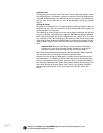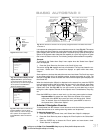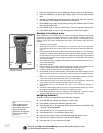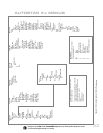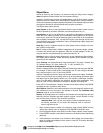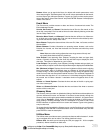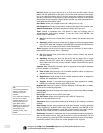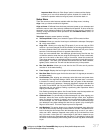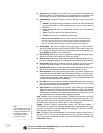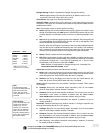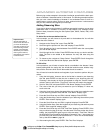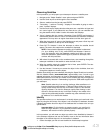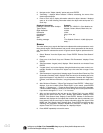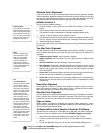
Tip:
If the "ENTER to Sync" f
ea
-
ture is accessed by mistake
(holding the ENTER key for
more than 2 seconds),
press MODE to return to
the previous screen.
ܖ Train Drive:All telescopes have a certain amount of "backlash" (looseness in the
inter
play of gears). This menu allows you to compensate for the backlash in the
the R.A. and Dec motors—which helps locate objects with more precision.
ܖ Tracking Rate: Changes the speed at which the telescope tracks targets in the
sky.
a. Sidereal: The default setting for Autostar II; sidereal rate is the standard rate
at which stars move from East to West across the sky due to the rotation of
the Earth.
b. Lunar: Choose this option to properly track the Moon over long observing
sessions.
c. Solar: Choose this option when observing the Sun.
c. Custom:
Allows entry of user-defined tracking rates.
Note: Custom Tracking Rate allows you to enter values from -999.999 to 999.999.
The lower the number, the slower the rate; the higher the number the faster the rate.
If you enter -999, the telescope will move so slow as to appear to be stopped. If you
enter 999, the telescope will be moving at approximately twice the tracking rate.
ܖ Guiding Rate: Allows you to change the base slew speed, 1x. Enter a percent-
age of the speed (less than 100%) and press ENTER.This function may be use-
ful in guiding the telescope during CCD and long-exposure photography. See
SLEW SPEEDS, page 26, for more information.
ܖ Dec Guiding: Allows a user using an autoguider to disengage autoguider inputs.
Allows you to select N & S, North only, South only, and off.
ܖ Reverse L/R: Reverses the functions of the Left and Right Arrow keys for con-
trolling the telescope's motion (i.e., the Right key moves the telescope to the left).
ܖ Reverse U/D: Reverses the functions of the Up and Down Arrow keys for con-
trolling the telescope's motion (i.e., the Up key moves the telescope down).
ܖ Home Sensor: Turns off or on the True North sensor, if preferred, for Easy, One-
Star, and Two-Star alignment. The default setting for this menu is "On."
ܖ GPS Alignment: Allows three options. Select "Off" if you wish to align the tele-
scope manually (turns off GPS). Select "On" (default setting) if you wish to auto-
matically align your telescope and want the telescope to get the GPS fix when it
is needed during alignment. Select "At Start Up" if you want the telescope to get
a GPS fix when the telescope is powered up.
ܖ R.A. PEC: Allows you to perform periodic error correction on the R.A. drive worm
gear
.
Must be performed with a high-power reticle (
eg., 9mm).
Y
ou may restore
the factory default setting by selecting “On.”
ܖ High Precision: If High Precision is tur
ned on, when looking f
or a f
aint celestial
object (
e
.g.
, a neb
ula or galaxy), A
utostar II first sle
ws to a nearb
y bright star and
displa
ys "ENTER to Sync." Center the star in the e
yepiece, then press ENTER.
At that point the telescope has a high precision alignment to that part of the sky
and it then slews to the object that was originally requested.
Time:
Changes the time entered into Autostar II. Setting the correct time is critical for
A
utostar II to properly calculate locations and events.Time may be set to "AM," "PM,"
or 24-hour mode (militar
y time).
T
o select the 24-hour mode
, press ENTER when the
the "b
lank" option displa
ys (
i.e
.
, neither "AM" nor "PM" is displa
y
ed).
Targets: Switches between Astronomical targets and Terrestrial targets. If
"Astronomical" is selected, the telescope tr
ac
king motor is activ
ated and an
y object
y
ou obser
v
e in the sky will remain centered in the e
yepiece. If "Terrestrial" is select-
ed, the tr
acking motor is turned off.
Date: Changes the date used by Autostar II.This function is useful to check events in
the past or future
.
F
or e
xample
:
Set the Date men
u f
or a da
y three months in the
future
.
Then chec
k the "Select Item:
Ev
ent" men
u for the Sunset time on that date.See
EVENT MENU, page 35.
38
Looking at or near the Sun will cause irreversible damage to your eye. Do not point this telescope at or near the
Sun. Do not look through the telescope as it is moving.



